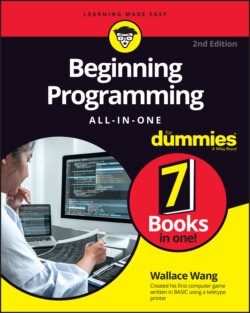Читать книгу Beginning Programming All-in-One For Dummies - Wallace Wang - Страница 110
ОглавлениеBook 2
Programming Basics
Contents at a Glance
1 Chapter 1: How Programs Work Using Keywords as Building Blocks Organizing a Program Dividing a Program into Subprograms Dividing a Program into Objects Creating a User Interface
2 Chapter 2: Variables, Data Types, and Constants Declaring Variables Using Different Data Types Storing Data in a Variable Retrieving Data from a Variable Using Constant Values Defining the Scope of a Variable
3 Chapter 3: Manipulating Data Storing Data with the Assignment Operator Using Math to Manipulate Numbers Manipulating Strings Finding Strings with Regular Expressions Using Comparison Operators Using Boolean Operators Converting Data Types
4 Chapter 4: Making Decisions by Branching Picking One Choice with the IF-THEN Statement Picking Two Choices with the IF-THEN-ELSE Statement Picking Three or More Choices with the IF-THEN-ELSEIF Statement Playing with Multiple Boolean Operators Making Multiple Choices with the SELECT CASE Statement
5 Chapter 5: Repeating Commands by Looping Looping a Fixed Number of Times with the FOR-NEXT Loop Looping Zero or More Times with the WHILE Loop Looping at Least Once with the DO Loop Playing with Nested Loops Prematurely Exiting from a Loop Checking Your Loops
6 Chapter 6: Breaking a Large Program into Subprograms Creating and Using Subprograms Passing Parameters Repeating a Subprogram with Recursion
7 Chapter 7: Breaking a Large Program into Objects How Object-Oriented Programming Works Encapsulation Isolates Data and Subprograms Sharing Code with Inheritance Polymorphism: Modifying Code without Changing Its Name Design Patterns Object-Oriented Languages Real-Life Programming Examples
8 Chapter 8: Reading and Saving Files Storing Data in Text Files Storing Fixed-Size Data in Random-Access Files Storing Varying-Size Data in Untyped Files Using Database Files
9 Chapter 9: Documenting Your Program Adding Comments to Source Code Writing Software Documentation
10 Chapter 10: Principles of User Interface Design The Evolution of User Interfaces Elements of a User Interface Designing a User Interface
11 Chapter 11: Debugging and Testing Common Types of Programming Errors Debugging with Comments and Print Statements Breakpoints, Stepping, and Watching Testing Code
